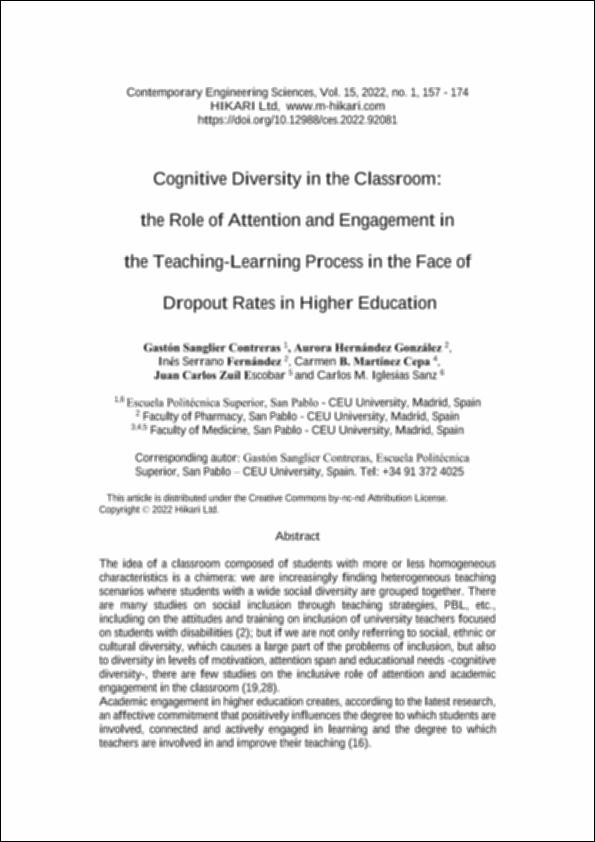Please use this identifier to cite or link to this item:
http://hdl.handle.net/10637/15954Cognitive Diversity in the Classroom: the Role of Attention and Engagement in the Teaching-Learning Process in the Face of Dropout Rates in Higher Education
| Title: | Cognitive Diversity in the Classroom: the Role of Attention and Engagement in the Teaching-Learning Process in the Face of Dropout Rates in Higher Education |
| Authors : | Sanglier Contreras, Gastón Hernández González, Aurora Serrano Fernández, Inés Martínez Cepa, Carmen Zuil Escobar, Juan Carlos Iglesias Sanz, Carlos Miguel |
| Keywords: | Atención.; Aprendizaje; Enseñanza |
| Publisher: | Hikari |
| Citation: | Sanglier Contreras, Gastón; Hernández González, Aurora; Serrano Fernández, Inés; Martínez Cepa, Carmen B.; Zuil Escobar, Juan Carlios y Iglesias Sanz, Carlos M. "Cognitive diversity in the classroom: the role of attention and engagement in the teaching-learning process in the face of dropout rates in higher education". Contemporary Engineering Sciences. Ed. HIKARI Ltd. (Sofía, 2022): 157-174. https://doi.org/10.12988/ces.2022.92081 |
| Abstract: | The idea of a classroom composed of students with more or less homogeneous characteristics is a chimera: we are increasingly finding heterogeneous teaching scenarios where students with a wide social diversity are grouped together. There are many studies on social inclusion through teaching strategies, PBL, etc., including on the attitudes and training on inclusion of university teachers focused on students with disabilities (2); but if we are not only referring to social, ethnic or cultural diversity, which causes a large part of the problems of inclusion, but also to diversity in levels of motivation, attention span and educational needs -cognitive diversity-, there are few studies on the inclusive role of attention and academic engagement in the classroom (19,28). Academic engagement in higher education creates, according to the latest research, an affective commitment that positively influences the degree to which students are involved, connected and actively engaged in learning and the degree to which teachers are involved in and improve their teaching (16). On the other hand, cognitive diversity in the classroom or knowledge-related diversity reflects the variety of student perspectives on learning, with the potential to enrich the group by diversifying and broadening heuristics and mental models, but may also show certain disabilities that hinder academic performance. The attached research proposal explores all of these parameters to help increase quality, equity, inclusion and success for all in education and training. |
| URI: | http://hdl.handle.net/10637/15954 |
| Rights : | http://creativecommons.org/licenses/by-nc-nd/4.0/deed.es |
| ISSN: | 1314-7641 |
| Issue Date: | 4-Jul-2022 |
| Center : | Universidad San Pablo-CEU |
| Appears in Collections: | Escuela de Politécnica Superior |
Items in DSpace are protected by copyright, with all rights reserved, unless otherwise indicated.


